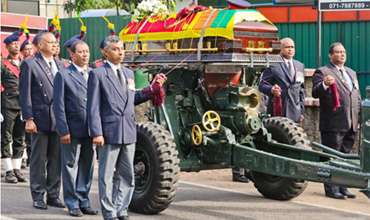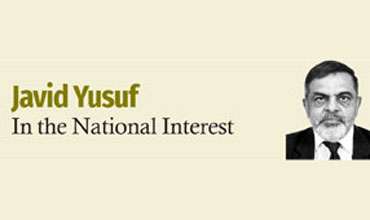Why Sri Lanka Imploded
 By Kaushik Basu
By Kaushik Basu
HAMBURG – As Sri Lanka’s economy unravels before our eyes, one must ask how this could happen in a country that is historically known for its high standard of living and stable economy. Sri Lanka’s achievements go back decades, giving it a per capita GDP that is 70% higher than India’s, and a life expectancy at birth of 77 years, compared to 73, 70, and 67, in Bangladesh, India, and Pakistan, respectively.
But now, Sri Lanka’s economy is in free fall. The proximate causes of the crisis are clear enough. Problems stemming from international factors such as COVID-19 and Russia’s war in Ukraine were exacerbated by Sri Lanka’s own policy mistakes. In 2019, President Gotabaya Rajapaksa (who has now fled the country) announced a round of mindless tax cuts, depriving the state of sorely needed revenue. Then, in 2021, his government abruptly banned imports of chemical fertilizer and pesticides. While the aim of the policy was to stall foreign-exchange outflows, the main result was a dramatic reduction in domestic food production, leading to acute food shortages this year.
The coup de grâce was the government’s ongoing effort to keep the Sri Lankan rupee artificially strong. Technically, Sri Lanka uses a “soft peg”: Rather than being fixed by government diktat, the rupee-to-dollar exchange rate is allowed to float, albeit with occasional interventions by the central bank (buying and selling dollars) to prevent excessive fluctuations.
But charting the rupee-to-dollar exchange rate shows that the country’s soft peg is a misnomer. For years, the exchange rate remained flat, roughly between 175 to 200 rupees to the dollar because, as economist Noah Smith explains, the Sri Lankan central bank was regularly selling dollars to prop up the rupee’s value. Eventually, this longstanding intervention ended the only way that it could: starting around April of this year, the rupee began depreciating sharply. Within months, the exchange rate had fallen to 350 rupees to the dollar, and the central bank’s dollar reserves had all but vanished.
Sri Lanka defaulted on its foreign debt in May. We now know that, rather than turning to the International Monetary Fund, whose rescue programs are conditional on tough policy reforms, it approached China for a fresh loan when its coffers were approaching empty. But this merely increased its debt by another $3 billion and ensured that its inevitable crisis would be even bigger when it eventually arrived.
China’s strategy vis-à-vis Sri Lanka (and other developing countries, like Ethiopia) echoes the approach taken both by earlier colonial powers and by rural moneylenders in developing countries. As Amit Bhaduri showed in a classic 1977 paper in the Cambridge Journal of Economics, rural informal moneylenders typically do not worry about the borrower defaulting; rather, they worry about the borrower not defaulting, because then they cannot turn a bigger profit by confiscating his collateral (usually his land).
Consider Hambantota Port, the pet project of Mahinda Rajapaksa, Sri Lanka’s president between 2005 and 2015 (and Gotabaya Rajapaksa’s brother). Funded largely with Chinese money, the port opened in 2010 on Mahinda’s birthday. But when Sri Lanka later failed to repay the debt, this “gift” became collateral to be confiscated. China now has a 99-year lease on the port.
How did a country with a longstanding reputation for maturity make so many mistakes? The short answer is that Sri Lanka’s politics sowed the seeds for today’s economic crisis. The Rajapaksa-led government became increasingly authoritarian after defeating the Liberation Tigers of Tamil Eelam and ending Sri Lanka’s decades-long civil war in 2009. It eroded the country’s democratic institutions, persecuted minorities, and waved away accusations of war crimes.
Although authoritarianism typically ends up destroying an economy, some authoritarian governments have managed to deliver economic growth and stability. For a short while, it seemed possible that the Rajapaksa government could fall into this category. But as it embraced populism, it soon became clear that crony capitalism would be Sri Lanka’s fate.
When the Rajapaksa government returned to power in 2019, it was riding a wave of support that it sought to sustain with ill-advised economic handouts. But the public’s patience can be bought for only so long. Eventually, unsustainable policies run into a wall.
If not for its hubris, the latest Rajapaksa government could have corrected course. When it came to power and immediately announced big tax cuts, it met with strong, sensible criticism. On October 30, 2019, for example, former Finance Minister Mangala Samaraweera warned, on Twitter, that, “Gota’s tax plan wants to set Sri Lanka on an express train to bankruptcy.” But Rajapaksa doubled down. When the government suddenly banned chemical-fertilizer imports, the implications of the policy were all too predictable.
Where it will end is unclear. Even if the Rajapaksas do not regain control by proxy, there are other risks. The IMF cannot offer a rescue program until there is a viable government with which to negotiate. But both the Fund and the Paris Club of sovereign creditors also will need to be proactive, suspending some of their bureaucratic rules to help Sri Lanka through this acute phase of the crisis. Failing that, a spiraling humanitarian disaster is the likeliest outcome.
Kaushik Basu, a former chief economist of the World Bank and chief economic adviser to the Government of India, is Professor of Economics at Cornell University and a non-resident senior fellow at the Brookings Institution.
Copyright: Project Syndicate, 2022.
www.project-syndicate.org
-
VJ Senthil
Tuesday, 26 July 2022 09:18 PMI have been reading a number of articles on restructuring of the Si Lankan economy, and also the reason for the breakdown. Of course, Corruption being the main reason, it was institutionalized in Sri Lanka specially in the last 15 years under the Rajapaksa regime. This is what China has taken maximum advantage of. Remember China always in its pursuit of becoming a World Power keeps looking out for countries where there is rampant corruption among its leaders so that they can be bribed to make their way into the country to get a foothold. Slowly they sell their 'Dreams' of making the country very developed by offering it to build their infrastructure, buildings, roads and bridges etc to make the country stand among the most developed nations, in order to attract Foreign Investments easily. The corrupt Govt gets sold by the idea and immediately gives it their approval. China works overtime to deliver everything promised and starts pressing the recipient country with a hefty Bill for the services rendered. The recipient country is unable to foot the bill and at the same time all the benefits promised are not forthcoming, hence there is no big revenue for the country to pay China its hefty Bill. China then offers them an option of surrendering a part of the countries Port or Airport. This is the first step China takes to takeover the country. After that they keep offering credit in millions of Dollars driving the recipient country deeper and deeper in financial crises. Until one day when the country is unable to pay any outside creditors and the economy collapses. This is what happened to Sri Lanka and the next in line is Pakistan. China has the same modus operandi everywhere in the third world where governments are weak and corrupt. India is the only country which has not fallen for these Chinese tactics and their economist already has seen through these Chinese ulterior designs and stayed away and had also warned other countries including Sri Lanka, but to no avail. If only Sri Lanka had listened to India way back then, they would have been saved form the crises they are in today. So today while building new Sri Lanka under new Government, first thing is do not involve China. Also my advise to Sri Lankan people is to drive out the Chinese people from Sri Lanka and go and occupy Hanbantota Port again and run it. Just as you were successful in putting down the LiTTe movement fifteen years back, just use the same guerilla tactics to drive out the Chinese from Sri Lanka today.
Likes : 0 Dislikes : 0
















Leave Comments